Mn-X (X = F, Cl, Br, I) Co-Doped GeSe Monolayers: Stabilities and Electronic, Spintronic and Optical Properties
Abstract
1. Introduction
2. Computational Methods
3. Results and Discussions
4. Conclusions
Supplementary Materials
Author Contributions
Funding
Data Availability Statement
Conflicts of Interest
References
- Novoselov, K.S.; Geim, A.K.; Morozov, S.V.; Jiang, D.; Zhang, Y.; Dubonos, S.V.; Grigorieva, I.V.; Firsov, A.A. Electric Field in Atomically Thin Carbon Films. Science 2004, 306, 666–669. [Google Scholar] [CrossRef]
- Liu, H.; Neal, A.T.; Zhu, Z.; Luo, Z.; Xu, X.; Tománek, D.; Ye, P.D. Phosphorene: An Unexplored 2D Semiconductor with a High Hole Mobility. ACS Nano 2014, 8, 4033–4041. [Google Scholar] [CrossRef]
- Song, L.; Ci, L.; Lu, H.; Sorokin, P.B.; Jin, C.; Ni, J.; Kvashnin, A.G.; Kvashnin, D.G.; Lou, J.; Yakobson, B.I.; et al. Large Scale Growth and Characterization of Atomic Hexagonal Boron Nitride Layers. Nano Lett. 2010, 10, 3209–3215. [Google Scholar] [CrossRef]
- Mak, K.F.; Lee, C.; Hone, J.; Shan, J.; Heinz, T.F. Atomically Thin MoS2: A New Direct-Gap Semiconductor. Phys. Rev. Lett. 2010, 105, 136805. [Google Scholar] [CrossRef] [PubMed]
- Ao, L.; Xiao, H.Y.; Xiang, X.; Li, S.; Liu, K.Z.; Huang, H.; Zu, X.T. Functionalization of a GaSe Monolayer by Vacancy and Chemical Element Doping. Phys. Chem. Chem. Phys. 2015, 17, 10737–10748. [Google Scholar] [CrossRef]
- Ma, Y.; Dai, Y.; Guo, M.; Yu, L.; Huang, B. Tunable Electronic and Dielectric Behavior of GaS and GaSe Monolayers. Phys. Chem. Chem. Phys. 2013, 15, 7098–7105. [Google Scholar] [CrossRef] [PubMed]
- Özdamar, B.; Özbal, G.; Çlnar, M.N.; Sevim, K.; Kurt, G.; Kaya, B.; Sevinçli, H. Structural, Vibrational, and Electronic Properties of Single-Layer Hexagonal Crystals of Group IV and V Elements. Phys. Rev. B 2018, 98, 045431. [Google Scholar] [CrossRef]
- Tyagi, K.; Waters, K.; Wang, G.; Gahtori, B.; Haranath, D.; Pandey, R. Thermoelectric Properties of SnSe Nanoribbons: A Theoretical Aspect. Mater. Res. Express 2016, 3, 035013. [Google Scholar] [CrossRef]
- Gajić, R.; Meisels, R.; Kuchar, F.; Hingerl, K. All-Angle Left-Handed Negative Refraction in Kagomé and Honeycomb Lattice Photonic Crystals. Phys. Rev. B Condens. Matter Mater. Phys. 2006, 73, 165310. [Google Scholar] [CrossRef]
- Gao, B.; Zhang, J.R.; Chen, L.; Guo, J.; Shen, S.; Au, C.T.; Yin, S.F.; Cai, M.Q. Density Functional Theory Calculation on Two-Dimensional MoS2/BiOX (X = Cl, Br, I) van Der Waals Heterostructures for Photocatalytic Action. Appl. Surf. Sci. 2019, 492, 157–165. [Google Scholar] [CrossRef]
- Xu, L.; Yang, M.; Wang, S.J.; Feng, Y.P. Electronic and Optical Properties of the Monolayer Group-IV Monochalcogenides MX (M = Ge, Sn; X = S, Se, Te). Phys. Rev. B 2017, 95, 235434. [Google Scholar] [CrossRef]
- Xu, Y.; Zhang, H.; Shao, H.; Ni, G.; Li, J.; Lu, H.; Zhang, R.; Peng, B.; Zhu, Y.; Zhu, H.; et al. First-Principles Study on the Electronic, Optical, and Transport Properties of Monolayer α- and β-GeSe. Phys. Rev. B 2017, 96, 245421. [Google Scholar] [CrossRef]
- Yap, W.C.; Yang, Z.; Mehboudi, M.; Yan, J.A.; Barraza-Lopez, S.; Zhu, W. Layered Material GeSe and Vertical GeSe/MoS2 p-n Heterojunctions. Nano Res. 2018, 11, 420–430. [Google Scholar] [CrossRef]
- Vaughn, D.D.; Patel, R.J.; Hickner, M.A.; Schaak, R.E. Single-Crystal Colloidal Nanosheets of GeS and GeSe. J. Am. Chem. Soc. 2010, 132, 15170–15172. [Google Scholar] [CrossRef]
- Hu, Y.; Zhang, S.; Sun, S.; Xie, M.; Cai, B.; Zeng, H. GeSe Monolayer Semiconductor with Tunable Direct Band Gap and Small Carrier Effective Mass. Appl. Phys. Lett. 2015, 107, 122107. [Google Scholar] [CrossRef]
- Zhao, Y.; Zhang, Y.; Yan, P.; Tu, J.; Xu, Y.; He, L. Increasing the Photocatalytic Properties of Monolayer Black Phase GeSe by 3d Transition Metal Doping: From Ultraviolet to Infrared Absorption. Mol. Catal. 2020, 496, 111195. [Google Scholar] [CrossRef]
- Yang, L.; Wu, M.; Yao, K. Transition-Metal-Doped Group-IV Monochalcogenides: A Combination of Two-Dimensional Triferroics and Diluted Magnetic Semiconductors. Nanotechnology 2018, 29, 215703. [Google Scholar] [CrossRef] [PubMed]
- Zhao, Y.; Li, X.; Li, H.; He, L. Surface Doping of Nonmetal Atoms Enhances Photocatalytic Performance of Monolayer GeSe for Degradation of Organic Pollution. Chem. Phys. Lett. 2021, 785, 139156. [Google Scholar] [CrossRef]
- Li, S.; Hou, Y.; Li, D.; Zou, B.; Zhang, Q.; Cao, Y.; Tang, G. Realization of High Thermoelectric Performance in Solution-Synthesized Porous Zn and Ga Codoped SnSe Nanosheets. J. Mater. Chem. A Mater. 2022, 10, 12429–12437. [Google Scholar] [CrossRef]
- Kresse, G.; Furthmüller, J. Efficient Iterative Schemes for Ab Initio Total-Energy Calculations Using a Plane-Wave Basis Set. Phys. Rev. B Condens. Matter Mater. Phys. 1996, 54, 11169–11186. [Google Scholar] [CrossRef]
- Blöchl, P.E. Projector Augmented-Wave Method. Phys. Rev. B 1994, 50, 17953–17979. [Google Scholar] [CrossRef] [PubMed]
- Perdew, J.P.; Burke, K.; Ernzerhof, M. Generalized Gradient Approximation Made Simple. Phys. Rev. Lett. 1996, 77, 3865–3868. [Google Scholar] [CrossRef]
- Guo, Y.; Zhou, S.; Bai, Y.; Zhao, J. Oxidation Resistance of Monolayer Group-IV Monochalcogenides. ACS Appl. Mater. Interfaces 2017, 9, 12013–12020. [Google Scholar] [CrossRef]
- von Rohr, F.O.; Ji, H.; Cevallos, F.A.; Gao, T.; Ong, N.P.; Cava, R.J. High-Pressure Synthesis and Characterization of β-GeSe—A Six-Membered-Ring Semiconductor in an Uncommon Boat Conformation. J. Am. Chem. Soc. 2017, 139, 2771–2777. [Google Scholar] [CrossRef] [PubMed]
- Leenaerts, O.; Sahin, H.; Partoens, B.; Peeters, F.M. First-Principles Investigation of B- and N-Doped Fluorographene. Phys. Rev. B Condens. Matter Mater. Phys. 2013, 88, 035434. [Google Scholar] [CrossRef]
- Baroni, S.; De Gironcoli, S.; Dal Corso, A.; Giannozzi, P. Phonons and Related Crystal Properties from Density-Functional Perturbation Theory. Rev. Mod. Phys. 2001, 73, 515–562. [Google Scholar] [CrossRef]
- Chakraborty, R.; Ahmed, S.; Subrina, S. Functionalization of Electronic, Spin and Optical Properties of GeSe Monolayer by Substitutional Doping: A First-Principles Study. Nanotechnology 2021, 32, 305701. [Google Scholar] [CrossRef]
- Shafique, A.; Shin, Y.H. Thermoelectric and Phonon Transport Properties of Two-Dimensional IV-VI Compounds. Sci. Rep. 2017, 7, 506. [Google Scholar] [CrossRef]
- Dyachenko, A.A.; Lukoyanov, A.V.; Shorikov, A.O.; Anisimov, V.I. Magnetically Driven Phase Transitions with a Large Volume Collapse in MnSe under Pressure: A DFT+DMFT Study. Phys. Rev. B 2018, 98, 085139. [Google Scholar] [CrossRef]
- Youn, S.J.; Min, B.I.; Freeman, A.J. Crossroads Electronic Structure of MnS, MnSe, and MnTe. Phys. Status Solidi (b) 2004, 241, 1411–1414. [Google Scholar] [CrossRef]
- Hung, T.L.; Huang, C.H.; Deng, L.Z.; Ou, M.N.; Chen, Y.Y.; Wu, M.K.; Huyan, S.Y.; Chu, C.W.; Chen, P.J.; Lee, T.K. Pressure Induced Superconductivity in MnSe. Nat. Commun. 2021, 12, 5436. [Google Scholar] [CrossRef] [PubMed]
- Park, S.Y.; Kim, P.J.; Lee, Y.P.; Shin, S.W.; Kim, T.H.; Kang, J.; Rhee, J.Y. Realization of Room-Temperature Ferromagnetism and of Improved Carrier Mobility in Mn-Doped ZnO Film by Oxygen Deficiency, Introduced by Hydrogen and Heat Treatments. Adv. Mater. 2007, 19, 3496–3500. [Google Scholar] [CrossRef]
- Bardeen, J.; Shockley, W. Deformation Potentials and Mobilities in Non-Polar Crystals. Phys. Rev. 1950, 80, 72–80. [Google Scholar] [CrossRef]
- Cai, Y.; Zhang, G.; Zhang, Y.W. Polarity-Reversed Robust Carrier Mobility in Monolayer MoS2 Nanoribbons. J. Am. Chem. Soc. 2014, 136, 6269–6275. [Google Scholar] [CrossRef]
- Li, D.; Zhang, X.; He, W.; Lei, L.; Peng, Y.; Xiang, G. Structure-Dependent High-TC Ferromagnetism in Mn-Doped GeSe. Nanoscale 2022, 14, 13343–13351. [Google Scholar] [CrossRef] [PubMed]
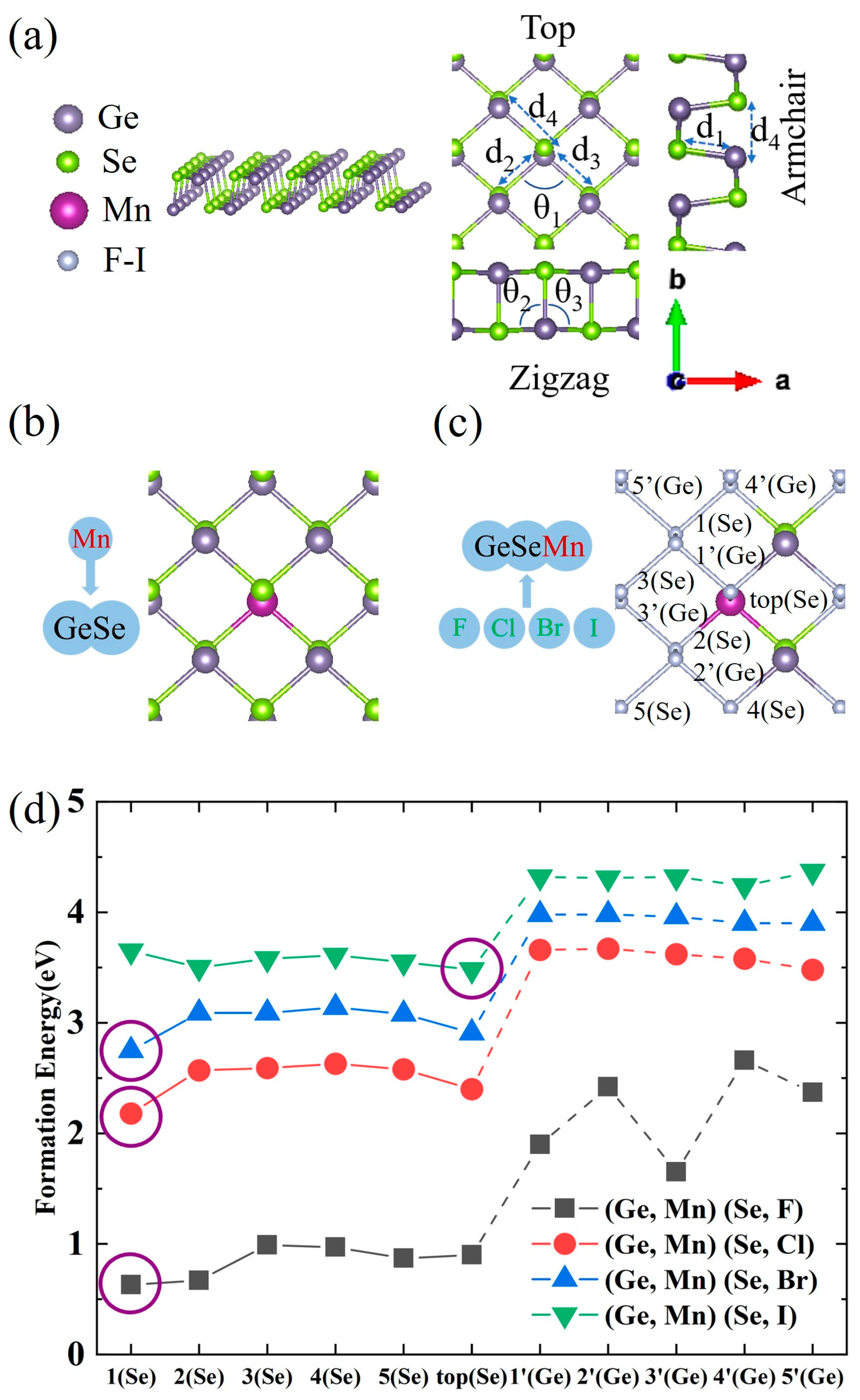
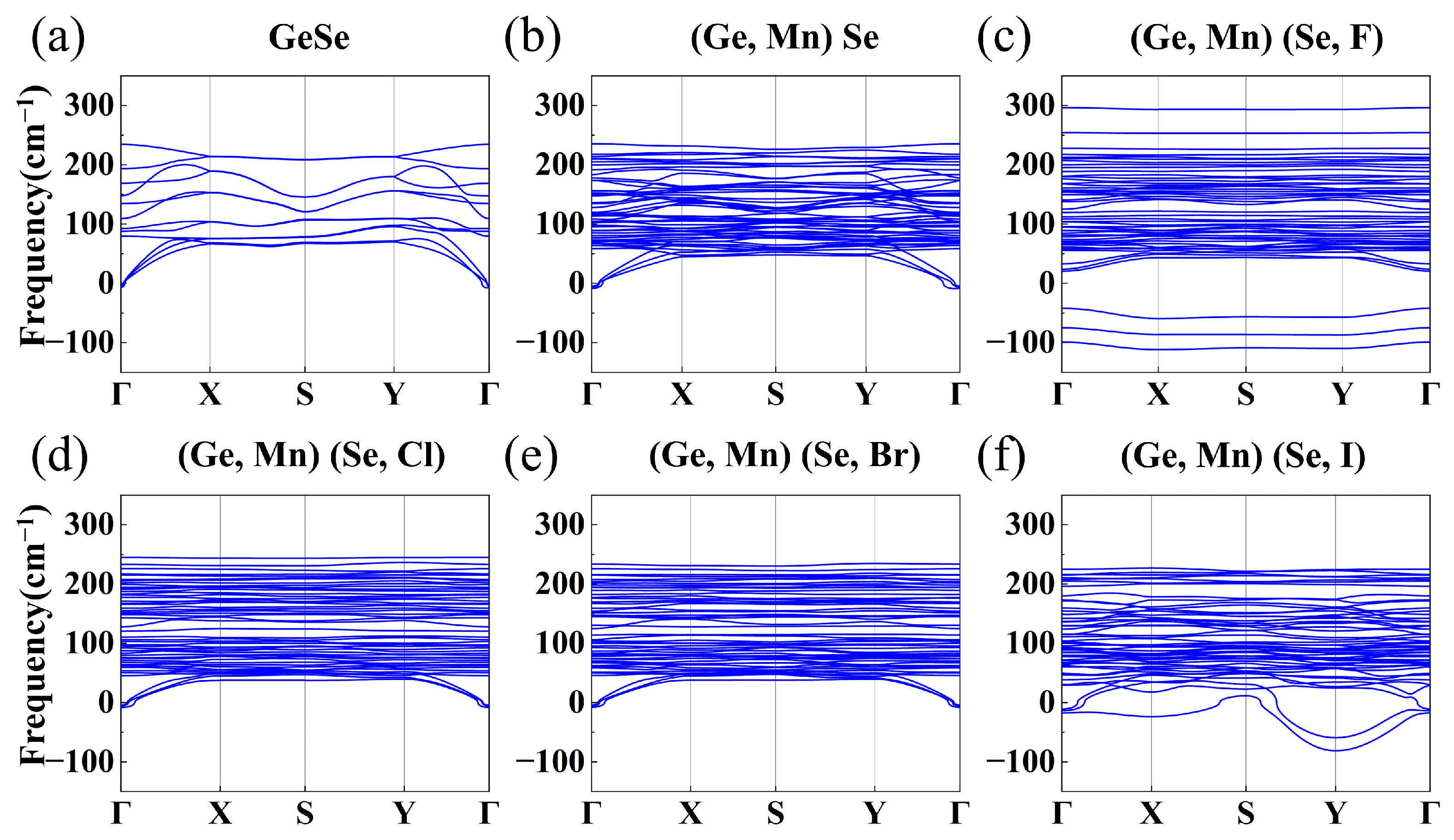
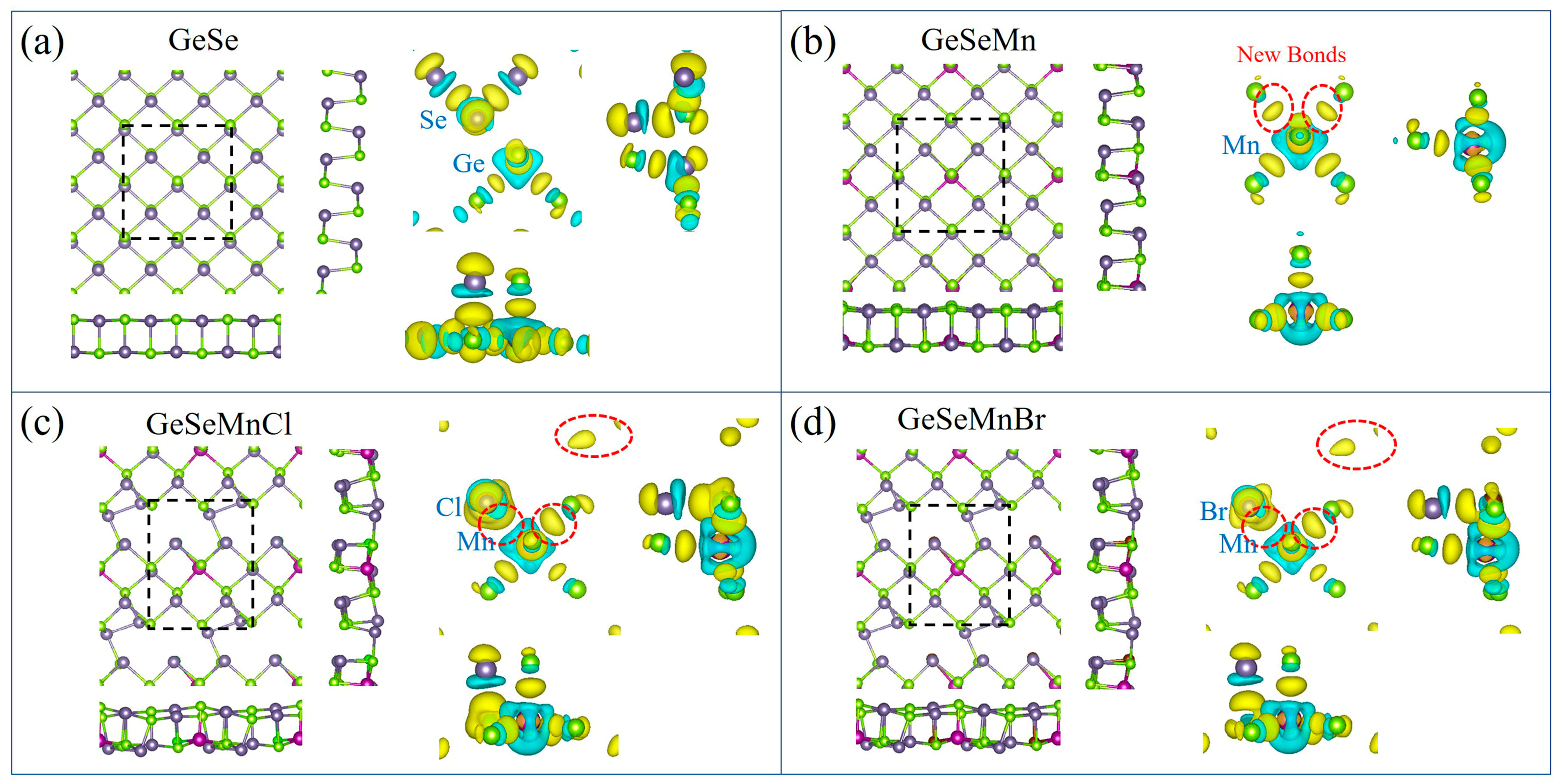
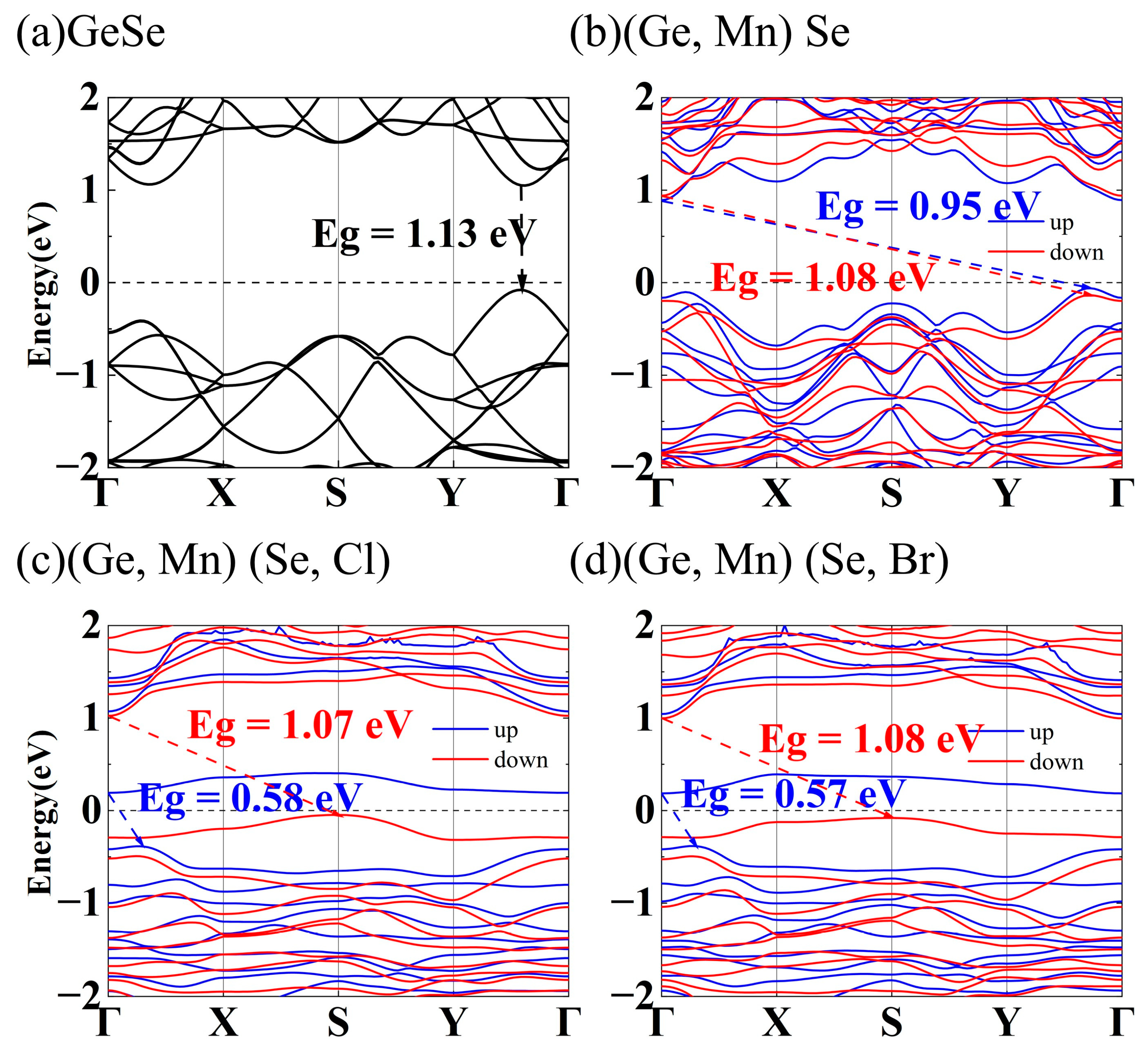

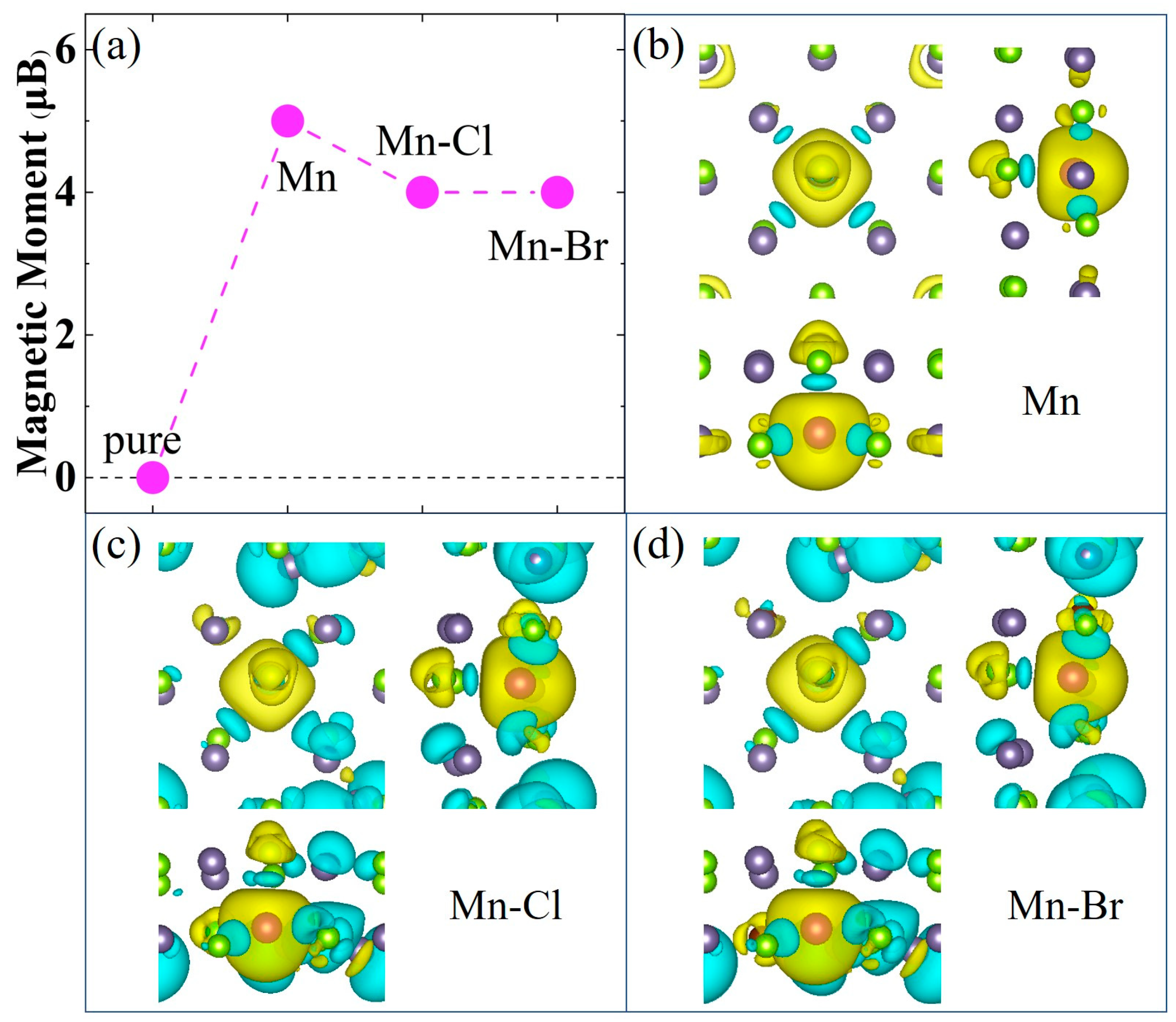
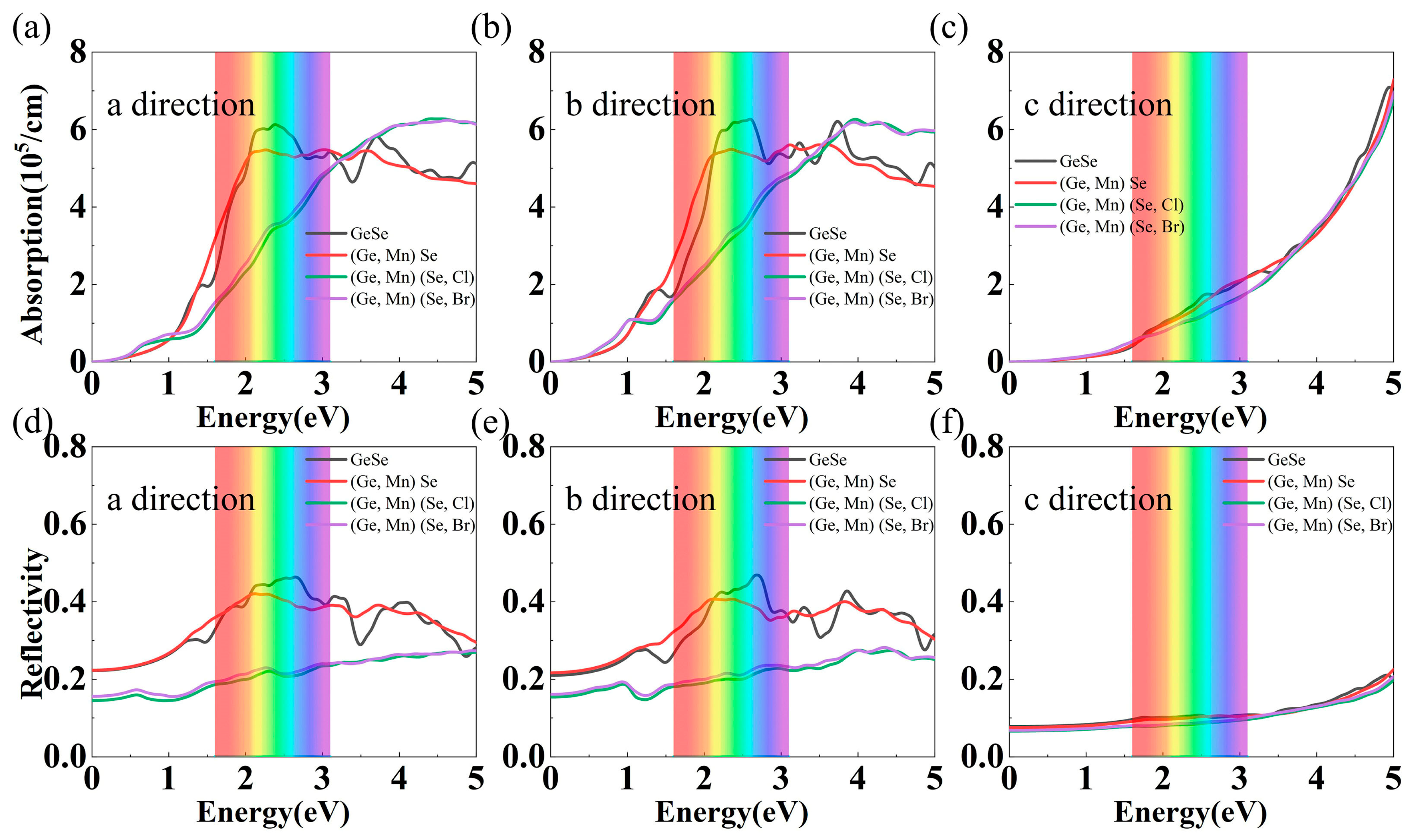
| Dopant | a (Å) | b (Å) | θ1˚ | θ2˚ | θ3˚ | d1 (Å) | d2 (Å) | d3 (Å) | d4 (Å) |
|---|---|---|---|---|---|---|---|---|---|
| None | 7.97 | 8.52 | 96.38 | 97.53 | 97.53 | 2.55 | 2.68 | 2.68 | |
| Mn | 7.96 | 8.27 | 92.96 | 101.55 | 101.55 | 2.57 | 2.68 | 2.68 | 2.86 |
| Mn-Cl | 7.84 | 9.19 | 89.60 | 108.49 | 97.18 | 2.59 | 2.62 | 2.79 | 2.61 |
| Mn-Br | 7.87 | 9.17 | 90.42 | 107.85 | 97.70 | 2.59 | 2.61 | 2.78 | 2.79 |
| Dopant | Spin | Bandgap (eV) |
|---|---|---|
| None | up | 1.13(D) |
| down | 1.13(D) | |
| Mn | up | 0.95(I) |
| down | 1.08(I) | |
| Mn-Cl | up | 0.58(I) |
| down | 1.07(I) | |
| Mn-Br | up | 0.57(I) |
| down | 1.08(I) |
| Dopant | Spin | Carrier | ma (m0) | mb (m0) | Ca (N/m) | Cb (N/m) | Ea (eV) | Eb (eV) | μa (cm2v−1s−1) | μb (cm2v−1s−1) |
|---|---|---|---|---|---|---|---|---|---|---|
| None | electron | 0.37 | 0.13 | 45.56 | 22.65 | 6.77 | 1.22 | 172 | 7494 | |
| hole | 0.31 | 0.14 | 45.56 | 22.65 | 10.18 | 4.92 | 96 | 450 | ||
| Mn | up | electron | 0.14 | 0.18 | 49.84 | 35.13 | 4.26 | 2.02 | 1735 | 4230 |
| hole | 0.32 | 0.18 | 49.84 | 35.13 | 7.06 | 5.80 | 183 | 339 | ||
| down | electron | 0.16 | 0.19 | 49.84 | 35.13 | 2.59 | 1.63 | 3739 | 5603 | |
| hole | 0.30 | 0.24 | 49.84 | 35.13 | 7.66 | 4.76 | 148 | 338 | ||
| Mn-Cl | up | electron | 1.79 | 6.94 | 29.05 | 33.79 | 0.31 | 1.52 | 673 | 8 |
| hole | 0.42 | 0.63 | 29.05 | 33.79 | 4.12 | 3.35 | 111 | 130 | ||
| down | electron | 0.24 | 0.4 | 29.05 | 33.79 | 3.23 | 0.65 | 526 | 9060 | |
| hole | 1.39 | 2.27 | 29.05 | 33.79 | 1.24 | 2.69 | 107 | 16 | ||
| Mn-Br | up | electron | 1.57 | 1.88 | 30.36 | 17.58 | 0.23 | 1.96 | 2987 | 20 |
| hole | 0.42 | 0.62 | 30.36 | 17.58 | 4.51 | 3.44 | 98 | 66 | ||
| down | electron | 0.26 | 0.35 | 30.36 | 17.58 | 2.4 | 0.8 | 944 | 3652 | |
| hole | 2.58 | 6.39 | 30.36 | 17.58 | 1.68 | 2.42 | 14 | 2 |
Disclaimer/Publisher’s Note: The statements, opinions and data contained in all publications are solely those of the individual author(s) and contributor(s) and not of MDPI and/or the editor(s). MDPI and/or the editor(s) disclaim responsibility for any injury to people or property resulting from any ideas, methods, instructions or products referred to in the content. |
© 2023 by the authors. Licensee MDPI, Basel, Switzerland. This article is an open access article distributed under the terms and conditions of the Creative Commons Attribution (CC BY) license (https://creativecommons.org/licenses/by/4.0/).
Share and Cite
He, W.; Zhang, X.; Gong, D.; Nie, Y.; Xiang, G. Mn-X (X = F, Cl, Br, I) Co-Doped GeSe Monolayers: Stabilities and Electronic, Spintronic and Optical Properties. Nanomaterials 2023, 13, 1862. https://doi.org/10.3390/nano13121862
He W, Zhang X, Gong D, Nie Y, Xiang G. Mn-X (X = F, Cl, Br, I) Co-Doped GeSe Monolayers: Stabilities and Electronic, Spintronic and Optical Properties. Nanomaterials. 2023; 13(12):1862. https://doi.org/10.3390/nano13121862
Chicago/Turabian StyleHe, Wenjie, Xi Zhang, Dan Gong, Ya Nie, and Gang Xiang. 2023. "Mn-X (X = F, Cl, Br, I) Co-Doped GeSe Monolayers: Stabilities and Electronic, Spintronic and Optical Properties" Nanomaterials 13, no. 12: 1862. https://doi.org/10.3390/nano13121862
APA StyleHe, W., Zhang, X., Gong, D., Nie, Y., & Xiang, G. (2023). Mn-X (X = F, Cl, Br, I) Co-Doped GeSe Monolayers: Stabilities and Electronic, Spintronic and Optical Properties. Nanomaterials, 13(12), 1862. https://doi.org/10.3390/nano13121862







